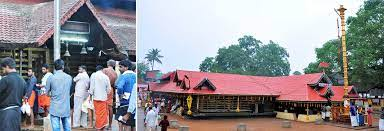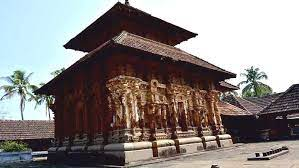Kottarakkara Ganapathi temple
Compiled by
P.R.Ramachander
This is one of the greatest Ganapathi temples of Kerala. Though called Ganapathi temple , it is really a part of the Kizhkkekara(eastern) Shiva temple
The story of origin goes like this. The legendary Perum THachan Who was helping to build the Padijattinkara (western) Shiva temple , one day started chiseling a piece of Jack wood while standing outside this temple and without his realizing he made a child Ganapathi idol (unni ganapathi) .He requested the poojari of the temple to consecrate this ganapathi also in the temple.The thanthri refused saying it was a shiva temple. Greatly disappointed the THachan took the statute to Kizhakke kara temple and the thanthri there agreed to consecrate the Ganapathy statue there
The priest agreed. Perumthachan viewed the place- Siva facing east, in front of that it is Ganga, Parvathy turned towards the west. Southwest there is Sastha and northwest Subrahmanya. If Ganapathy too is installed, Siva family will be complete. The place will be none other than Kailas itself. Thus Ganapathy was installed southeast by Perumthachan.
After consecrating The priest m, Perum thachan told the priest that the unni ganapathi must be hungry and what the priest has to offer him.The priest replied , he has prepared , Unniapam, ab nd he agreed to offer that to the new Unni Ganapathi. ,The priest stringed 6 or 7 unniapam and placed them on a leaf and gave it to thachan,It was later known as Kootaapam(collection of unni appam).After offering it Perum thachan told the priest that though the temple belongs to his father , in future, it would be known as his temple
It becae a practice in this temple to prepare the unni appam in front of the Ganapathi, after the sanctum is opened,It is made of raw rice, jaggery and Kadalai pazham(variety of Banana) , along with ghee and sugar.This is made till the cloasure of temple and is termed as Udhayayasthamana pooja.These are freely distributed to the devotees.
It seems the lord of Kotaakkara, Kottarakkra thampuran, did not have issues, offered it to God and he was blessed with a baby.
It is believed by offering this udhayasthamana pooja all our wishes would be fulfilled.
Like most other Vinayaka temples, here also Ashtadravya Ganapathyhomam acquires a prominent place. Other important offerings includes, breaking of coconuts, Thulabharam, Chathussatham, Thrimadhuram, Archana and Pushpanjali. Udayasthamaya pooja and Ashtadravya Ganapathyhomam can be performed through advanced booking.
Festivals
Vinayaka Chathurthy
Vinayaka Chathurthi Lord Vinayaka’s birthday falls on the
chathurthi day of the bright half of the Malayalam month ‘chingam’. This
particular day is marked with great Mahaganapathy Homam, using 1008 coconuts.
Besides Unniyappam, Modhakam is also offered to Ganapathy. The other major
ceremonies includes Sarvaiswarya pooja, Gajapooja, Annadanam etc.
Medathiruvathira
This is the famous day of Thirvarattu. The large scale
festival celebrations of eleven days come to an end on this day. Kettukazhcha
is a major attraction of the day.
Mandalachirappu
Kottarakara temple is an edathavalam (resting place) for
the sabarimala pilgrims. Special bhajana and poojas are being performed in the
Dharmasastha nada.
Sivarathri
The festival during the month of Kumbham,is marked by
special poojas for Lord Siva.
Ayilyam-Makam
Special poojas for the Nagadaivanjal. The Nagaprathishta
was done by Pambummekkattu Thanthrikal.
Navarathri
Every year grand Navarathri celebrations will be held at
the Devitemple. Thousands throng to the temple to perform the Vidyarambham of
their little ones.
Prathishtadinam(Cosecration day)
This falls on the Uthrittathy nakshatra of Makara masa.
Bhagavatha Sapthaham, Devibhaghavatha Navaham,Annadhanam are the major events.
Thyppooyam
Kavdiyattam and other rituals are being performed in the
Muruga temple.
Vishu
Vishu is a Hindu festival primarily celebrated in the
Indian state of Kerala, which marks the beginning of the new year. For
malayalees this is a very special day which marks a prosperous beginning.
People from every nook and corners of the area come here to seek the blessings
of Lord Ganapathy.
Timings
Morning
04:00 AM Palliyunarthal
04:30 AM Nadathurappu
04.40 AM Nirmalyam
04:50 AM Abhishekam
05.30 AM Ashtadravya Ganapathihomam
06.00 AM Usha Pooja
07.00 AM Ethritheu Pooja
07.15 AM Sreebali
09.00 AM Pantheeradi Pooja
10:00 AM Navaka Pooja
10.30 AM Ucha Pooja
11:00 AM Uchasreebali
11:30 AM Nadayadappu
Evening
Evening
5:00 PM Nadathurakkal
6:30 PM Deeparadhana
7:30 PM Athazha Pooja
7:45 PM Athazha Sreebali
8:00 PM Nadayadappu
How to reach Kottarakkara Ganapathy Temple?
By Road: Buses and Taxis can be boarded from Kottarakkara, Kollam, Trivandrum and Kottayam that takes the passengers directly to the Kottarakkara Sree Maha Ganapathy Temple.
By Rail: The Nearest Railway station is Kottarakkara station. Board a train passing through Kottarakkara, Kollam and Trivandrum railway stations to reach the temple. Kollam station is at a distance of 28 Km and Trivandrum at a distance of 70 Km.
By Air: The Nearest Airport is Trivandrum Airport that is 70 Km from the temple. Kochi Airport is at a distance of 191 Km.
Where to stay near Kottarakkara Ganapathy Temple?
There are many hotels as well as guest rooms near the hotel. The rooms are well equipped with all the basic amenities.
Ambalakkara Regency Hotel Contact: Pulamon Junction, Kottarakkara
Harisree Residency Contact: Kottiyam Kundara Road, Perumpuzha, Kottamkara
Hotel Indraprastha Pattazhy Contact: Market Junction, Pattazhy P.O., Kollam
Hotel Midhuna International Contact: Enathu, Kottarakara – Adoor Road
Park Residency Contact: Paracode, Kayamkulam Pathanapuram Highway
Hotel Vrindhavanam Inn Contact: Near KSRTC Bus Station, Punalur




